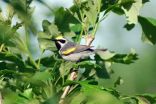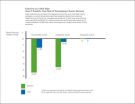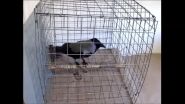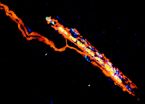While tracking a population of golden-winged warblers, a research team led by ecologist Henry Streby at the University of California, Berkeley, discovered that birds in the mountains of eastern Tennessee fled their breeding grounds one to two days ahead of the arrival of powerful supercell storms. The storm system swept through the central and southern United States in late April 2014, generating 84 confirmed tornadoes and killing 35 people.
"It is the first time we've documented this type of storm avoidance behavior in birds during breeding season," said Streby, who conducted the work while he was a National Science Foundation postdoctoral fellow and a visiting research scholar in UC Berkeley's Department of Environmental Science, Policy and Management. Other members of the team were biologists at the University of Minnesota, the University of Tennessee and the U.S. Geological Survey.
"We know that birds can alter their route to avoid things during regular migration, but it hadn't been shown until our study that they would leave once the migration is over and they'd established their breeding territory to escape severe weather," said Streby. "The warblers in our study flew at least 1,500 kilometers (932 miles) total to avoid a severe weather system. They then came right back home after the storm passed."
Notably, the birds fled while the storm was still 250-560 miles away, and local environmental cues to inclement weather - including changes in atmospheric pressure, temperature and wind speed - were largely absent.
"At the same time that meteorologists on the Weather Channel were telling us this storm was headed in our direction, the birds were apparently already packing their bags and evacuating the area," said Streby.
The researchers described this "evacuation migration" of the warblers in a paper to be published Thursday, Dec. 18, in the journal Current Biology.
An accidental discovery
The unplanned exodus was a collateral finding to an ongoing study of the birds' migratory pattern. Golden-winged warblers regularly spend their winters in Central and South America before returning to North America's Great Lakes and Appalachian Mountain regions to breed.
There is growing urgency to study the golden-winged warblers; although the birds' numbers are stable in the Great Lakes, their population is only 5 percent of historic levels in the Appalachians due to factors such as habitat loss and hybridization with other species.
The researchers were testing whether a bird so small - an adult golden-winged warbler weighs about 9 grams, roughly equivalent to four dimes - could successfully carry a half-gram geolocator throughout the year. To obtain the tracking data, the researchers had to retrieve as many geolocators as possible from the 20 birds that had been originally tagged. The new study results come from five geolocators with usable data.
"These warblers are the smallest bird species ever marked," said Streby. "The fact that any geolocators came back at all was a relief."
After examining the data, the researchers found anomalies in the geographical locations for the birds from April 26 to May 2. It appeared that the birds reversed course and flew back from their breeding grounds in Tennessee's Cumberland Mountains to the Gulf coast. This was odd since golden-winged warblers usually stay put after returning to their breeding grounds to establish their territory and raise their young.
The researchers initially thought the readings were a mistake, but when they went through their data again, they could not find errors consistent with known factors that can throw off geolocator readings. The search for an alternate explanation began.
"We remembered the supercell storm because we also had to evacuate to a hotel to wait out the storm," said Streby.
But when the birds left town, the local weather conditions were normal. The researchers wondered how the birds got their alert, and infrasound emerged as the most logical explanation.
Infrasonic sounds of Earth
Acoustic waves that occur at frequencies below 20 hertz (cycles per second) fall into the infrasound range, which is below the normal limits of human hearing. Birds and other animals, however, have been shown to hear infrasound. When winds blow over mountains, ocean waves crash onto shorelines and volcanoes erupt, they create higher frequencies that are discernible by humans. But those events also generate infrasound waves that can travel thousands of kilometers away.
The lower the frequency, the farther the sound waves can travel. The powerful explosion of a nuclear bomb can be detected acoustically across the globe, for instance, which is why there is a network of infrasound arrays worldwide that is used to monitor compliance with the Comprehensive Nuclear Test Ban Treaty.
Scientists have known for decades that tornadoes produce very strong infrasound, and that birds can hear and respond to infrasound frequencies.
In 2000, research by Jon Hagstrum, a geophysicist at the U.S. Geological Survey in Menlo Park, found that before supersonic flights were discontinued, the infrasonic noise from Concorde jets could interfere with the ability of racing pigeons to find their way home. His paper was the first evidence beyond the laboratory that birds use infrasound to orient themselves.
"Pigeons use the geomagnetic field and the sun as compasses and directional guides, but those markers make terrible maps," said Hagstrum, who was not part of the warbler study. "Pigeons still need a map to determine which direction home is, and the source of that map had been unclear until recently. My work suggests that birds use infrasound as their map."
Hagstrum said the new paper about warbler's clearing out before tornadoes hit presents convincing evidence that birds also use infrasound to remotely detect storms.
"Biologists had not been looking at the use of infrasound in this way, but it certainly makes sense to me," he said. "We may find that acoustics are a pretty significant way that birds in general view their environment, much like dogs use olfaction and humans use sight."
The ability of birds to forecast massive storms could become increasingly important in the decades ahead, the study authors said.
"There's growing research that shows that tornadoes are becoming more common and severe with climate change, so evasive actions like the ones the warbler took might become more necessary," said Streby. "It could come at a cost, though, since such actions place added energetic and reproductive stress on populations that are already struggling."
INFORMATION:
The U.S. Fish and Wildlife Service and the U.S. Geological Survey helped support this research.




